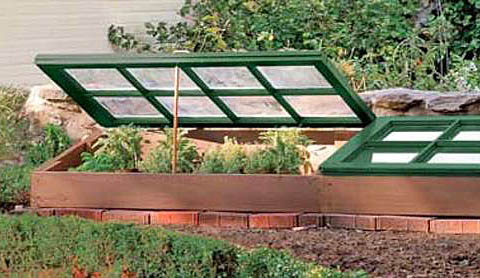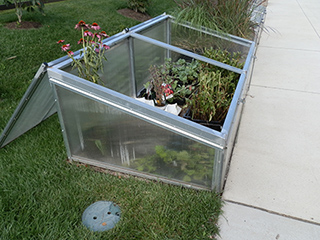Cold Frames: A Way to Extend Your Growing Season
By Pat Dickey, Fairfax Master Gardener

Old windows and cedar frame
If you are looking for a way to begin your vegetable gardening earlier and to extend the growing season by several weeks, why not use a cold frame? You will be able to grow leafy greens and other crops that are adaptable to colder weather in early spring, late fall, or in winter if the temperatures aren’t too frigid. You will also be able to cover existing plants in the fall prior to frost to extend their harvest. The cold frame will also be a place to harden off your seedlings before planting them into your garden. It provides a way to transition your seedlings to the outdoors or to keep your seedlings protected until the weather is warm enough for them.
A cold frame is a bottomless box with a clear or translucent, removable top. Woods such as cedar or cypress are best for the base of the frame because they won’t decay. The size of your cold frame depends on how much space you have and how many seeds or seedlings you want to plant inside. Try to make your frame about 3 to 4 feet wide so that you can easily reach across it to tend to your plants. Remember to water what is growing inside the cold frame, because it will not receive any natural rainfall.

Commercial cold frame with lucite and aluminum frame
Polyethylene or a Lucite sheet of plastic are most suitable to use for the top of the cold frame. Many gardeners also use windows as the top. Older windows should be checked for possible lead-based paint. County community gardening also prohibits the use of glass inside the plots.
Place your cold frame in a sunny, well-drained section of your garden. A southern exposure is best for absorbing the most sun and heat. It should also be on a slight slope for good drainage. A wall or row of shrubs can offer some protection from harsh wind on the north side of your frame. Experts also suggest that you sink the cold frame into the ground, allowing the soil around it to provide additional insulation. You should also be able to easily walk around the cold frame and have an area where you can remove and store the top when not needed in warmer weather.
It is important to protect your plants in the cold frame from sudden changes in cold or hot temperatures. In case there is a sudden period of extremely cold temperatures, have insulating materials ready. Burlap bags filled with leaves, blankets or bales of straw or hay will offer needed insulation if placed on top of the cold frame. You can also add a floating row cover over the plants under the cold frame to provide protection. Be careful on early spring days when temperatures are over 50 degrees F. The top of the cold frame should be raised to vent the inside and prevent extremely hot temperatures from “cooking” your plants. A thermometer placed inside will help to monitor the heat and cold. Lower the top each day in the early evening to conserve the heat from the daytime exposure.
For those who cannot build a cold frame, there are cold frame kits available including high tech ones with automatic ventilation equipment that will raise and lower the top.
References
Use a Cold Frame to Grow Vegetables in the Winter, Joni Blackburn, Brooklyn Botanic Garden
Garden All Winter With a Cold Frame, Sussex County Master Gardener Gaye Mara, Delaware Cooperative Extension
Start Your Garden Early With Cold Frames, Bonnie Kirn Donahue, University of Vermont
Building and Using Hotbeds and Cold Frames,David Trinklein, University of Missouri Extension
Thank you to Molly O’Boyle, a Fairfax County Master Gardener, for her contributions to this article.
… updated 2024